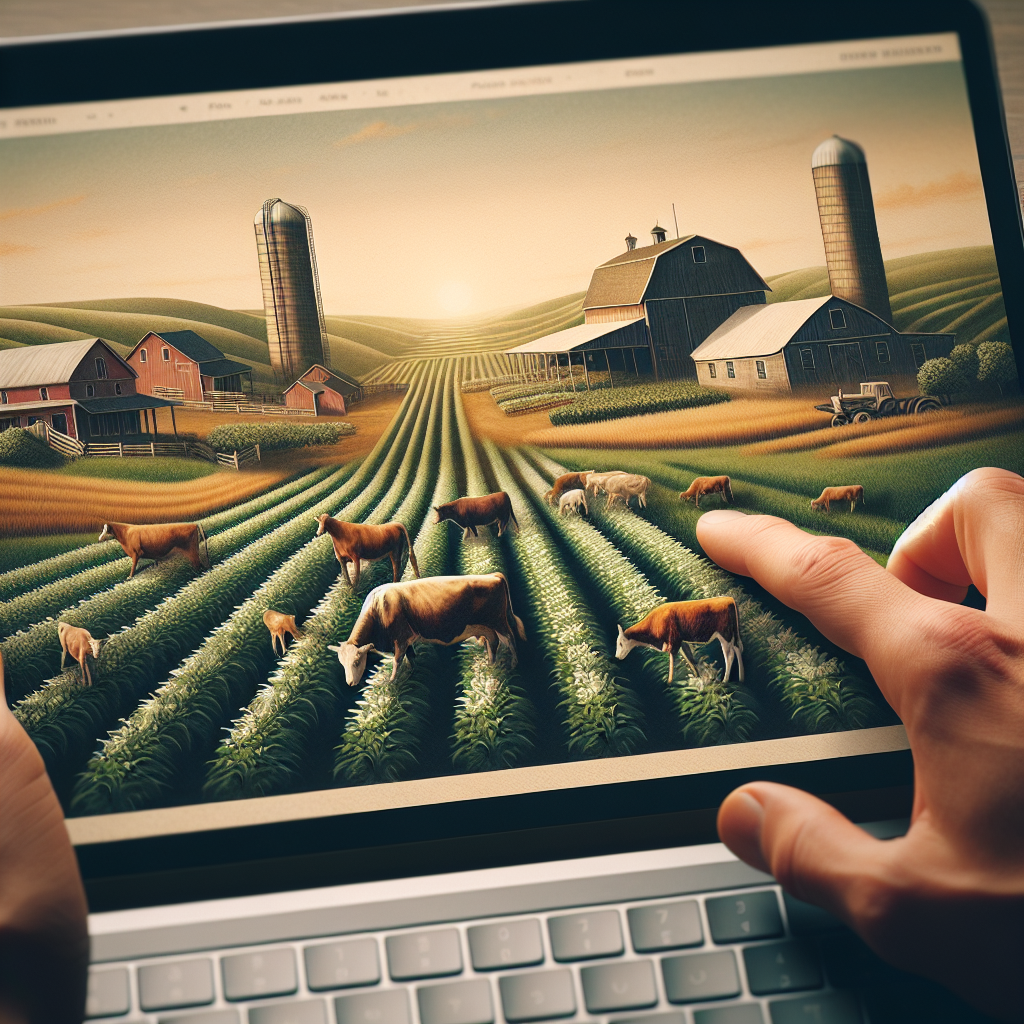Introduction: Why Farmers Need Websites
With the digital age taking over, farmers aren’t an exception.
What once seemed quite conventional and hands-on is now realizing the benefits of being part of the digital world.
But why do farmers need websites?
Let’s think of how individuals and businesses have been thriving in the pandemic-stricken world. Digital presence has not just been a nice-to-have but a must-have aspect for many, if not all.
Can this be true for farmers as well?
Undeniably, the answer is yes! In this article, we touch upon the advantages of having a farmer’s website, the essential features it should offer, and how to build one. We also bring forward the success stories to justify the proficiency of this digital evolution for farmers.
So, let’s begin the conversation about creating a space for farmers on the World Wide Web!
Table of Contents
Do Farmers Need Websites?
Benefits of Having a Website for Farmers
Farmers today face unique challenges, but having a website can offer significant benefits:
- Increased Visibility: A website helps farmers reach a broader audience.
- Direct Sales: Farmers can sell produce directly to consumers.
- Brand Building: It helps in creating a unique brand identity.
- Information Distribution: Farmers can more easily share news and updates.
A website can serve as a 24/7 marketing tool, providing critical information to potential customers and partners.
Essential Features of a Farmer’s Website
If you decide to build a website, consider incorporating these essential features:
- Product Listings: Showcase available produce or products.
- Online Store: Facilitate online orders directly from the website.
- Contact Information: Make it easy for people to get in touch.
- About Us Page: Share the farm’s story and background.
- Blog Section: Publish updates, farming tips, and seasonal product info.
These features will help enhance customer engagement and streamline operations.
How to Build a Website
Creating a website may seem daunting, but it’s manageable with these steps:
| Step | Description |
|---|---|
| Select a Domain Name | Choose a memorable domain name relevant to your farm. |
| Pick a Hosting Service | Select a reliable hosting service to keep your site running smoothly. |
| Design Your Website | Use website builders like WordPress or Wix, or hire a web designer. |
| Add Content | Incorporate text, images, and features that represent your farm well. |
| Launch | Publish your site and promote it via social media and other channels. |
These steps will guide you from the planning stage to launching your website effectively.
Success Stories
Many farmers have successfully enhanced their business through websites.
For example, according to Forbes, small farms that have adopted digital marketing tools, including websites, have seen a notable increase in direct-to-consumer sales, boosting their revenues significantly.
Having a well-designed website has proven to be advantageous for farmers by enhancing their visibility and providing new avenues for sales.
Website Building: An Overview
What is Building a Website?
Simply put, building a website involves crafting a digital ‘house’ where internet users can visit to get to know more about you, your products, and services.
This creation task intertwines design, coding, content creation, and strategizing to deliver a functional, user-friendly, and appealing platform. As every business varies in its requirements, creating a website can range from setting up a basic one-page site with a text editor to integrating complex web functionalities using a web development framework.
Comprehending Website Building for Farmers
In context to farmers, website building primarily focuses on enhancing online visibility, easing direct sales, crafting unique brand identity, and aiding efficient information distribution. Whether they use a simple DIY website builder or hire web professionals, the task’s core remains the same – developing a platform that successfully connects farmers with customers, partners, and the community.
Steps in Website Building
Further into the Website Building Process: Detailing the Steps
The website building process aligns to the requirements of individual businesses, with steps that can be tailored depending on the complexity of the website, budget, and timeline.
- Strategy Formulation: Begin with defining the website’s purpose, target audience, key content, and features.
- Wireframing: Sketch out the basic design, arrangement of elements, and the website’s functionality.
- Prototype Development and Testing: Create a working model, refine the design, and test for usability.
- Launch and Maintenance: After thorough testing and review, launch the website. Regular maintenance and updates are crucial to keep the website up-to-date and functional.
Remember, development doesn’t end with the site’s launch. Maintenance is a significant part of the process.
Website Building for Farmers: A Case in Point
Mulling over the steps mentioned earlier for the farming context, the development will start with planning around producing a website best showcasing the farm and its offerings. Wireframing may involve designing navigation menus, a blog section, an online store, etc. Prototyping can include designing a fully-functional ‘Online Store’, testing it for usability and refining it. Once you and your users are satisfied with the website, only then should you proceed to launch it.
Website Building: Not as Tough as It Seems
While some business owners may get alarmed at the website development idea, it’s not as challenging as it seems at first. For instance, in the case of farmers, developing a website can be the savior in this digital age. It allows them to connect directly with consumers, increase their products’ visibility, and even carve a unique niche for themselves.
Website Building and Farmers: The Connection
Website Building for Farmers: En Route Success
Website building can be the kickstart farmers need in this digital world. As Forbes reports, small farms that have incorporated websites into their business strategy have seen a substantial boom in direct consumer sales.
Website building, when done right, is not merely about having an online presence. It’s about creating a platform that serves as a bridge between farmers and consumers – open 24/7 and packed with valuable content about your farm’s offerings. It can be your ticket to achieving greater business success.
The Bridge: Website Building Connecting Farmers and the World
Building a website can connect farmers to the world, bringing the rural produce to urban tables effortlessly. A good website brings in higher visibility, offers more comfortable sales opportunities, helps make a unique brand identity, and provides streamlined information to customers. Build a website, build a bridge to better business opportunities!
Advantages of Integrating Modern Technology into Farming Websites
Enhanced Customer Interaction Tools
As the digital age accelerates, integrating modern technology into farming websites can further enhance customer engagement:
- Live Chat: Real-time customer service can answer FAQs and assist with orders.
- Social Media Integration: Seamlessly connect your site with social media platforms to engage more effectively with a wider audience.
- Email Newsletters: Automated newsletters can keep customers updated on farm news, product availability, and special promotions.
Modern tools can transform a basic website into an interactive, customer-friendly platform, thereby expanding your digital footprint.
Utilizing E-commerce for Farm Produce
E-commerce isn’t just for large businesses. Farms can also leverage this technology:
- Subscription Services: Offering subscription boxes for weekly or monthly produce delivery can maintain steady revenue.
- Interactive Product Pages: High-quality images, detailed descriptions, and user reviews can influence purchasing decisions positively.
- Secure Payment Gateways: Implementing secure payment options builds trust and eases the buying process.
By incorporating an e-commerce platform, farms can considerably increase their sales and market presence.
Data Analytics for Optimizing Farm Operations
A farm website isn’t just about selling products; it can also be a powerful tool for data collection and analysis:
- Customer Insights: Track customer behavior to understand product preferences and buying patterns.
- Inventory Management: Analyze sales data to keep track of stock and manage supply effectively.
- Seasonal Trends: Use data analytics to anticipate high-demand seasons and adjust production accordingly.
Data-driven decisions can significantly refine your business strategy, promoting efficiency and profitability.
Educational Content for Community Engagement
Expanding beyond products, a farm website can also serve as an educational resource for the community:
- Blogs and Articles: Informative posts about farming techniques, sustainability, and seasonal produce can educate and engage your audience.
- Workshops and Events: Announce upcoming farm tours, workshops, and events to foster community relationships.
- Tutorial Videos: Share video content demonstrating various farming practices, which can be especially engaging for younger audiences.
Connecting through educational content can enhance community support and loyalty towards your farm.
Mobile Optimization for On-the-Go Access
With the growing use of smartphones, it’s crucial to ensure your website performs well on mobile devices:
- Responsive Design: Ensure your website adapts to various screen sizes for optimal viewing.
- Fast Load Times: Optimize images and scripts to reduce load times, especially important for mobile users.
- Mobile-Friendly Navigation: Simplify navigation so users can easily find information or make purchases on their mobile devices.
A mobile-optimized website ensures you’re not missing out on a significant portion of your potential audience.
Enhanced SEO Practices for Better Visibility
Improving your website’s visibility on search engines can drive more organic traffic to your site:
- Keyword Optimization: Research relevant keywords and integrate them into your web content.
- Meta Descriptions: Craft compelling meta descriptions to improve click-through rates from search engine results.
- Local SEO: Utilize local SEO strategies to appear in local search results, crucial for farms serving specific regions.
Implementing advanced SEO practices can ensure your farm website reaches a broader audience organically.
For more insights and tips on leveraging technology for farming, refer to Agricultural Websites and Digital Marketing.
By incorporating these modern technological features, farmers can transform their websites from simple information hubs into dynamic, multifunctional platforms that drive business growth and community engagement.
In Conclusion
In the age of digital marketing, creating a website is an essential step for farmers keen on enhancing their business. Websites increase visibility, streamline direct sales, aid in brand building, and facilitate smooth information distribution.
Elements like product listings, an online store, clear contact information, an ‘About Us’ page, and a blog section are recommended to enhance user engagement. Building a website might seem daunting, but with a clear plan and reliable tools, it is more than manageable.
Many farmers have experienced success with this strategy, and services like WordPress or Wix are equipped to help more individuals join this digital trend in farming.
Aided by elements like e-commerce, customer interactions, data analytics, educational content, mobile optimization, and SEO practices, it becomes easier than ever for a farming website to succeed. Let’s embrace this digital age and grow together!
Frequently Asked Questions – FAQs
Why is having a website beneficial for farmers?
A website increases visibility, enables direct-to-consumer sales, helps in creating a unique brand identity, and facilitates easy information distribution.
What are some essential features of a farmer’s website?
Effective features include product listings, an online store, easily accessible contact information, an ‘About Us’ page, and a blog section.
Is it difficult to create a website?
While it might seem daunting initially, tools and services like WordPress or Wix have made the process simpler and more manageable.
How have farmers benefited from creating websites?
Many farmers have seen increased visibility, higher sales, and stronger brand presence after creating their websites.
What advanced features could be useful for a farming website?
Features like e-commerce portals, customer interaction tools, data analytics, educational content, mobile optimization, and SEO practices can significantly enhance a farming website’s effectiveness.






